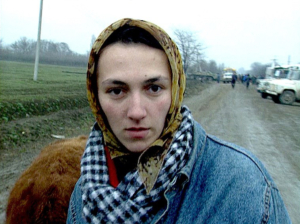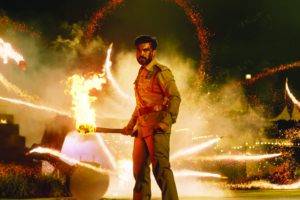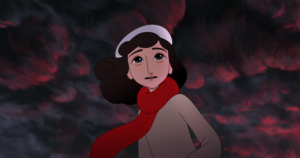Released in 2017, Pixar’s animated film Coco (Lee Unkrich) is a breathtakingly poignant and memorable experience, taking viewers on a splendid journey through the colourful and symbolic landscape of Mexico’s annual Day of the Dead[1]Known in Spanish as Día de Muertos or Día de los Muertos. festival. A story of a young boy who is desperately trying to follow his dream of becoming a musician despite being blocked by a deep, multigenerational family wound, Coco is a film about the importance of tradition, family and unity, and how inflexibility and an unwillingness to forgive can impede or even extinguish individuality and self-realisation. It is also about memory and the act of ritualised remembering, and how the latter is used to create bonds of enduring meaning; the film suggests that, by linking individuals to their ancestors, the Day of the Dead celebration allows those who have gone before to act as an anchor, a steadying force in a rapidly changing and uncertain world. Conversely, the film also explores the impact of forgetting, not only on the lives of those who are still in the land of the living, but also, significantly, on those who have transitioned across to the Land of the Dead.
These concepts are strongly presented in a range of different ways throughout Coco, making it a rich offering of layered themes, flawed but sympathetic characters and a story that touches the heart while challenging us to reflect on our own journeys towards becoming the people we want to be. Ultimately, the film poses an important and complex question for its audience to consider: should an individual sacrifice their personal dreams in order to maintain family order, peace and unity? The sensitive and intelligent way in which Coco builds on and explores this question culminates in a balanced and sincere resolution. The film challenges audiences with its emotional authenticity, as well as through its ability to combine the magic of animation with some of the most personal questions about family, death and remembering that each human being holds at the epicentre of their ‘self’.
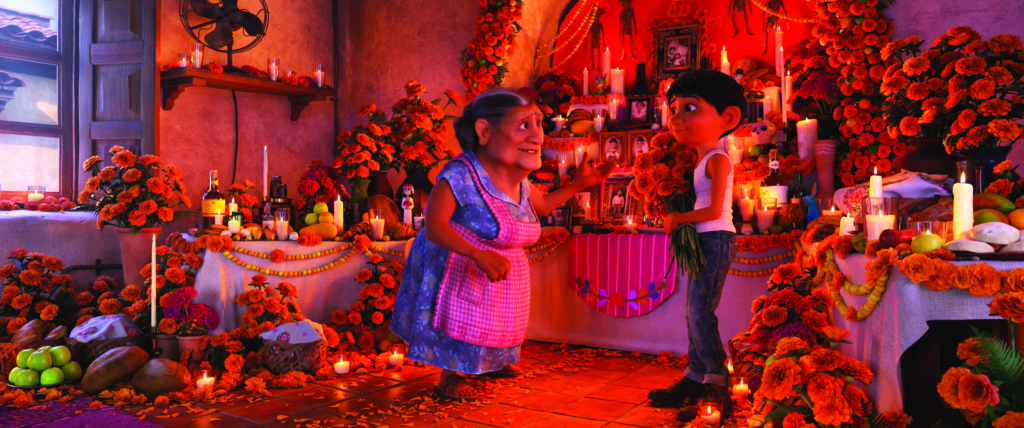
Background
Coco is a film that is set within a very specific cultural context: that of Mexico, its people, and their cultural, spiritual and religious beliefs. Most noticeably, the film focuses on the vital role that family and ancestry play in the lives of its characters, exploring in particular how past generations continue to wield influence on those living now. This is illustrated in two significant ways. The first is through the figure of the family matriarch, Elena Rivera (Renee Victor), better known to twelve-year-old protagonist Miguel (Anthony Gonzalez) as ‘Abuelita’, or ‘Granny’. Elena is also the daughter of the film’s titular character, Mamá Coco (Ana Ofelia Murguía), who suffers from dementia, and whose importance to the storyline becomes clear in the film’s climax. Elena’s role as matriarch is to take charge at home as well as serve as the head of the family’s shoemaking business. She is also the keeper and protector of the ancestral wound, manifested as a family ban on the playing of music.
Secondly, through the film’s exploration and use of the annual Day of the Dead festival and the particular rituals that are performed as part of it, Coco brings the audience up close to the extremely important place that family has in the world that it depicts. As we travel with Miguel into the Land of the Dead on a mission that only he can complete, Mexican symbols and spiritual beliefs about family, life and death are laid bare in a uniquely honest, funny and poignant manner.
Coco asks us to look objectively at the perceived sins of our ancestors, and to realise that we cannot know everything that shaped their decisions or their fates during their lifetimes.
Fully understanding Coco requires us first to understand something about the Day of the Dead. Held annually from 31 October to 2 November, the festival is celebrated throughout Latin America, and combines indigenous Aztec rituals with European Catholicism.[2]See ‘Day of the Dead (Día de los Muertos)’, History. com, updated 28 October 2019, <https://www.history.com/topics/halloween/day-of-the-dead>, accessed 26 February 2020. During the three-day holiday, people dress up as calacas (skeletons) and paint calaveras (skulls) on their faces to symbolise the inevitability of death and to show that they don’t fear it.[3]See ‘Dia de los Muertos’, National Geographic, <https://www.nationalgeographic.org/media/dia-de-los-muertos/>, accessed 26 February 2020. The inclusion of the dead in the celebrations highlights the firm place that they still hold within the family, as does the placement of their photos on each family’s home’s ofrenda, an altar-like table that holds small gifts and candles that have been lit in their honour. Observers also bring offerings of food and drinks to their deceased ancestors, carrying them into the cemetery and creating a party scene at their graves. All of this is done to welcome back and communicate with the spirits of their loved ones, who, it is believed, cross over from the Land of the Dead to participate (Coco represents their path as a bridge of marigold petals). A heartfelt celebration of the lives of those who have been lost, the Day of the Dead is a vibrant testimony to the love, commitment and continuity that can exist within families. This deeply embedded custom affirms the importance that Latin American cultures place on ancestry, and demonstrates a firmly held spiritual belief that death is a natural and inevitable aspect of the cycle of life.[4]‘Dia de los Muertos: A Brief History’, National Hispanic Cultural Center website, <http://online.nationalhispaniccenter.org/D%C3%ADa-de-los-muertos/origins.html>, accessed 26 February 2020.
Coco draws attention to the belief that to be forgotten on the Day of the Dead is to lose your place in this vital cycle of life and death – to suffer a final death. This idea, which is central to the film, also illustrates for the audience that our memories of the dead are crucial to who we are now. Through the magic of animation, the film sends Miguel, who views his family as blocking him from being who he desires to be, to the Land of the Dead to meet his long-passed ancestors and find out the truth behind why he is not allowed to learn or play music. In doing so, Coco explores what it means to belong to a family while still preserving one’s own individuality.
• What cultural beliefs does your family hold regarding death and loss?
• How does your family celebrate the anniversaries of loved ones who have passed away?
• In pairs, create a research poster highlighting the beliefs and customs associated with the Day of the Dead. Include information about your own cultural beliefs on the poster, too.
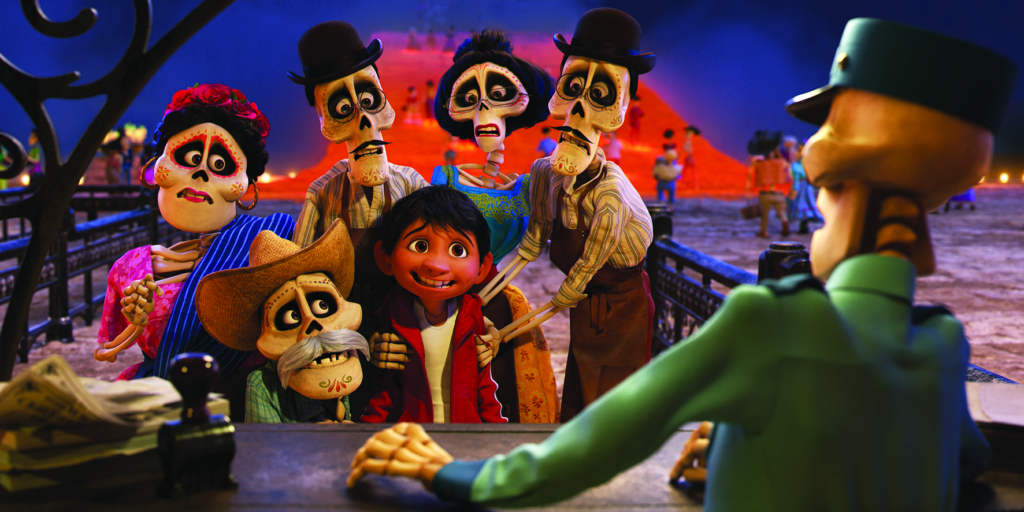
Thematic concerns
Coco’s portrayal of how family can stifle individual growth and self-realisation is highly relevant and relatable. Miguel’s dream of becoming a famous guitar player is threatened by his family’s ban on music. This proscription initially seems irrational, but stems from a deep wound; Miguel’s great-great-grandmother Imelda (Alanna Ubach) imposed it after her husband chose a life as a musician above staying at home with her and their daughter, Coco. Despite his family’s strict expectations of him, Miguel remains dedicated to his personal dream, which only grows stronger. Miguel is struggling to work out who he is, and naturally looks to his family for permission to be the person he dreams of becoming. This need for family approval is echoed in his quest in the Land of the Dead. While there, he searches for Ernesto de la Cruz (Benjamin Bratt), the man he initially believes is his great-great-grandfather, in the hope that the latter’s blessing will allow Miguel to not only return to the land of the living, but also help him finally feel that he has permission to become who he wants to be. This desire to find someone in his ancestry who is just like him and who can help to explain what he feels is a natural part of growing up, and his journey suggests that who we are is shaped at least in part by our family trees.
The Latin American cultural belief that death is just a transition into another life lends gravity to this idea. Through its representation of the Land of the Dead as a colourful, vibrant city where deceased family members are reunited with family and friends, Coco suggests that death is nothing to be afraid of so long as one is never forgotten by one’s family. This is poignantly illustrated through the character of Hector (Gael García Bernal), a deceased soul who is trying to sneak out of the Land of the Dead in order to cross the marigold bridge to visit his family on the Day of the Dead. It is from Hector that Miguel learns about the ‘final death’, the moment when a soul disappears from the Land of the Dead because they have finally been forgotten by their family who are still living. Hector tells Miguel that he is desperate to get his picture back to his family’s ofrenda because he fears he is running out of time. Although Miguel is desperate to pursue his own mission and return home, when he agrees to help Hector, he comes one step closer to unlocking the truth about his own ancestry. The discovery that it is Hector who is his real great-great-grandfather – and that he was murdered by Ernesto, his jealous musical partner – helps Miguel understand why he did not return home to Imelda and Coco all of those years ago.

This revelation both calls to our attention the imperfection of families and speaks to our human need to cultivate relationships based on understanding and forgiveness, not fear, judgement and reactivity. Mamá Coco, now almost completely lost in the grip of dementia, is the last person left alive who can remember her father, Hector. Yet, when Miguel plays the song that Hector wrote for her when she was a little girl, Coco is roused from the depths of her deep ‘forgetting’ and begins to sing along with him. Cue the tears! With this last act, Hector’s memory is restored, and his image is firmly placed on the family’s ofrenda.
• Think, pair, share. Think about a family tradition that is passed down through your family generation after generation. Do you resent that you are expected to do this? Or do you look forward to participating in something that your family has always observed? This could be a religious rite of passage, or a secular (non-religious) one. Pair up with other people in the room and share your information with them and listen to theirs.
• Work with a partner to brainstorm on paper the types of expectations that family members have of one another. List some of the reasons that individuals may or may not wish to meet family expectations. Talk about and list some of the potential consequences of not being true to yourself in order to please family members.

Conclusion
Coco concludes on an emotional high that affirms and embraces the psychological and emotional work involved in belonging to a family. It communicates to the audience that none of us can or would exist without our families and ancestors, but that each individual has a moral responsibility to make peace with what their family means to them. The film also asks us to look objectively at the perceived sins of our ancestors, and to realise that we cannot know everything that shaped their decisions or their fates during their lifetimes. Death is a boundary we cannot penetrate until it is our own time to traverse it; only through the magic of animation and imagination can one cross the marigold bridge into the Land of the Dead and ask one’s ancestors the kinds of questions that might aid one on life’s complex journey of self-discovery.
Endnotes
| 1 | Known in Spanish as Día de Muertos or Día de los Muertos. |
|---|---|
| 2 | See ‘Day of the Dead (Día de los Muertos)’, History. com, updated 28 October 2019, <https://www.history.com/topics/halloween/day-of-the-dead>, accessed 26 February 2020. |
| 3 | See ‘Dia de los Muertos’, National Geographic, <https://www.nationalgeographic.org/media/dia-de-los-muertos/>, accessed 26 February 2020. |
| 4 | ‘Dia de los Muertos: A Brief History’, National Hispanic Cultural Center website, <http://online.nationalhispaniccenter.org/D%C3%ADa-de-los-muertos/origins.html>, accessed 26 February 2020. |


